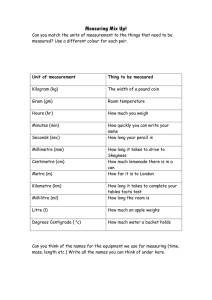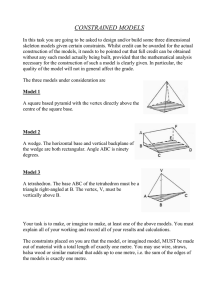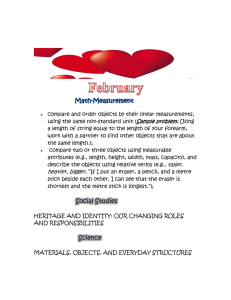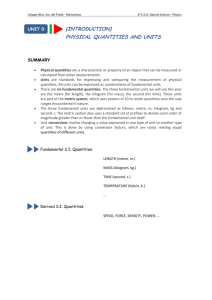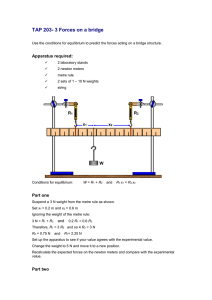A concise summary of the International System of Units, the
advertisement
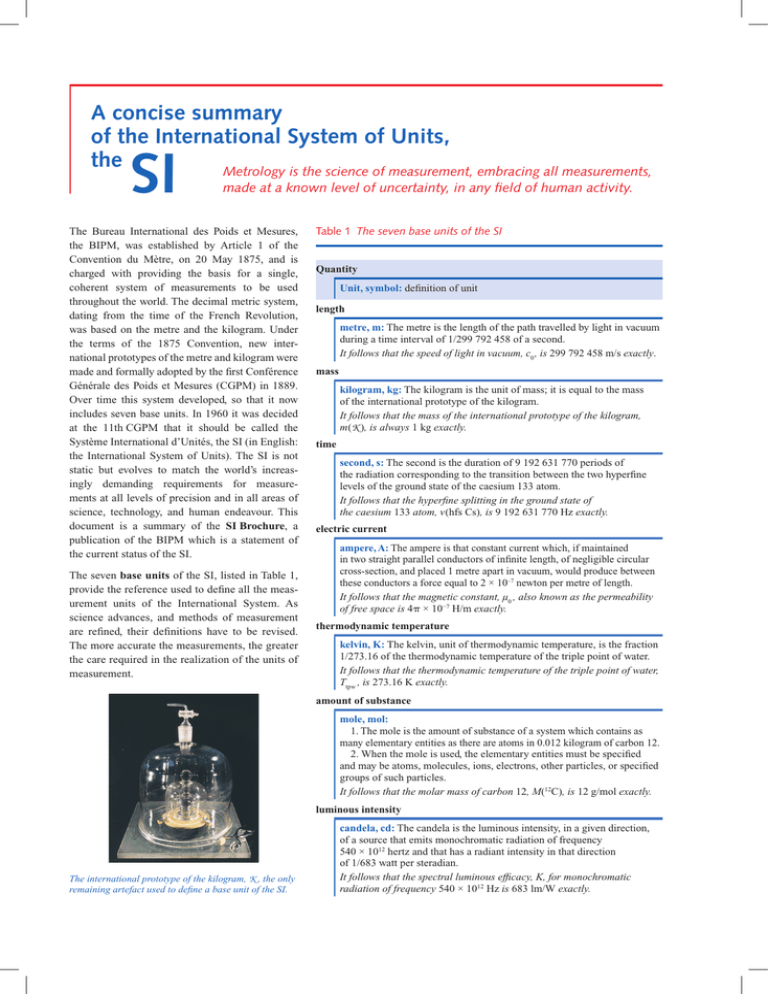
A concise summary of the International System of Units, the Metrology is the science of measurement, embracing all measurements, SI made at a known level of uncertainty, in any field of human activity. The Bureau International des Poids et Mesures, the BIPM, was established by Article 1 of the Convention du Mètre, on 20 May 1875, and is charged with providing the basis for a single, coherent system of measurements to be used throughout the world. The decimal metric system, dating from the time of the French Revolution, was based on the metre and the kilogram. Under the terms of the 1875 Convention, new international prototypes of the metre and kilogram were made and formally adopted by the first Conférence Générale des Poids et Mesures (CGPM) in 1889. Over time this system developed, so that it now includes seven base units. In 1960 it was decided at the 11th CGPM that it should be called the Système International d’Unités, the SI (in English: the International System of Units). The SI is not static but evolves to match the world’s increasingly demanding requirements for measurements at all levels of precision and in all areas of science, technology, and human endeavour. This document is a summary of the SI Brochure, a publication of the BIPM which is a statement of the current status of the SI. The seven base units of the SI, listed in Table 1, provide the reference used to define all the measurement units of the International System. As science advances, and methods of measurement are refined, their definitions have to be revised. The more accurate the measurements, the greater the care required in the realization of the units of measurement. Table 1 The seven base units of the SI Quantity Unit, symbol: definition of unit length metre, m: The metre is the length of the path travelled by light in vacuum during a time interval of 1/299 792 458 of a second. It follows that the speed of light in vacuum, c0 , is 299 792 458 m/s exactly. mass kilogram, kg: The kilogram is the unit of mass; it is equal to the mass of the international prototype of the kilogram. It follows that the mass of the international prototype of the kilogram, m(K ), is always 1 kg exactly. time second, s: The second is the duration of 9 192 631 770 periods of the radiation corresponding to the transition between the two hyperfine levels of the ground state of the caesium 133 atom. It follows that the hyperfine splitting in the ground state of the caesium 133 atom, v (hfs Cs), is 9 192 631 770 Hz exactly. electric current ampere, A: The ampere is that constant current which, if maintained in two straight parallel conductors of infinite length, of negligible circular cross-section, and placed 1 metre apart in vacuum, would produce between these conductors a force equal to 2 × 10–7 newton per metre of length. It follows that the magnetic constant, µ0 , also known as the permeability of free space is 4 × 10−7 H/m exactly. thermodynamic temperature kelvin, K: The kelvin, unit of thermodynamic temperature, is the fraction 1/273.16 of the thermodynamic temperature of the triple point of water. It follows that the thermodynamic temperature of the triple point of water, Ttpw , is 273.16 K exactly. amount of substance mole, mol: 1. The mole is the amount of substance of a system which contains as many elementary entities as there are atoms in 0.012 kilogram of carbon 12. 2. When the mole is used, the elementary entities must be specified and may be atoms, molecules, ions, electrons, other particles, or specified groups of such particles. It follows that the molar mass of carbon 12, M(12C), is 12 g/mol exactly. luminous intensity The international prototype of the kilogram, K , the only remaining artefact used to define a base unit of the SI. candela, cd: The candela is the luminous intensity, in a given direction, of a source that emits monochromatic radiation of frequency 540 × 1012 hertz and that has a radiant intensity in that direction of 1/683 watt per steradian. It follows that the spectral luminous efficacy, K, for monochromatic radiation of frequency 540 × 1012 Hz is 683 lm/W exactly. The seven base quantities corresponding to the seven base units are length, mass, time, electric current, thermodynamic temperature, amount of substance, and luminous intensity. The base quantities and base units are listed, with their symbols, in Table 2. Table 2 Base quantities and base units used in the SI joule, symbol J, is by definition equal to m2 kg s−2. There are 22 special names for units approved for use in the SI at present, and these are listed in Table 4. Table 4 Derived units with special names in the SI Derived quantity Name of derived unit Symbol for unit Expression in terms of other units plane angle radian rad m/m = 1 solid angle steradian sr m2/m2 = 1 Base quantity Symbol Base unit Symbol length l, h, r, x metre m mass m kilogram kg time, duration t second s frequency hertz Hz s–1 electric current I, i ampere A force newton N m kg s−2 thermodynamic temperature T kelvin K pressure, stress pascal Pa N/m2 = m−1 kg s−2 amount of substance mole mol energy, work, amount of heat joule J N m = m2 kg s−2 n luminous intensity Iv candela cd power, radiant flux watt W J/s = m2 kg s−3 electric charge, amount of electricity coulomb C sA electric potential difference volt V W/A = m2 kg s−3A−1 capacitance farad F C/V = m−2 kg−1 s4 A2 electric resistance ohm Ω V/A = m2 kg s−3 A−2 All other quantities are described as derived quantities, and are measured using derived units, which are defined as products of powers of the base units. Examples of derived quantities and units are listed in Table 3. Table 3 Examples of derived quantities and units Derived quantity Symbol Derived unit Symbol area A square metre m2 S V cubic metre m3 electric conductance siemens volume A/V = m−2 kg−1 s3 A2 speed, velocity v metre per second m/s magnetic flux weber Wb acceleration a metre per second squared m/s2 Vs= m2 kg s−2 A−1 tesla T wavenumber , ~v reciprocal metre m magnetic flux density Wb/m2 = kg s−2 A−1 mass density kilogram per cubic metre kg/m3 inductance henry H Wb/A = m2 kg s−2 A−2 surface density A kilogram per square metre kg/m2 Celsius temperature degree Celsius o specific volume v cubic metre per kilogram m3/kg luminous flux lumen lm cd sr = cd illuminance lux lx lm/m2 = m−2 cd ampere per square metre A/m2 activity referred to a radionuclide becquerel Bq s−1 absorbed dose, specific energy (imparted), kerma gray Gy J/kg = m2 s−2 dose equivalent, ambient dose equivalent sievert Sv J/kg = m2 s−2 catalytic activity katal kat s−1 mol current density j −1 magnetic field strength H ampere per metre A/m concentration c mole per cubic metre mol/m3 mass concentration , kilogram per cubic metre kg/m3 luminance Lv candela per square metre cd/m2 refractive index n one 1 relative permeability µr one 1 Note that refractive index and relative permeability are examples of dimensionless quantities, for which the SI unit is the number one, 1, although this unit is not written. Some derived units are given a special name, these being simply a compact form for the expression of combinations of base units that are used frequently. Thus, for example, the C K Although the hertz and the becquerel are both equal to the reciprocal second, the hertz is only used for cyclic phenomena, and the becquerel for stochastic processes in radioactive decay. The unit of Celsius temperature is the degree Celsius, o C, which is equal in magnitude to the kelvin, K, the unit of thermodynamic temperature. The quantity Celsius temperature t is related to thermodynamic temperature T by the equation t/oC = T/K − 273.15. The sievert is also used for the quantities directional dose equivalent and personal dose equivalent. The last four special names for units in Table 4 were adopted specifically to safeguard measurements related to human health. For each quantity, there is only one SI unit (although it may often be expressed in different ways by using the special names). However the same SI unit may be used to express the values of several different quantities (for example, the SI unit J/K may be used to express the value of both heat capacity and entropy). It is therefore important not to use the unit alone to specify the quantity. This applies both to scientific texts and also to measuring instruments (i.e. an instrument read-out should indicate both the quantity concerned and the unit). Dimensionless quantities, also called quantities of dimension one, are usually defined as the ratio of two quantities of the same kind (for example, refractive index is the ratio of two speeds, and relative permittivity is the ratio of the permittivity of a dielectric medium to that of free space). Thus the unit of a dimensionless quantity is the ratio of two identical SI units, and is therefore always equal to one. However in expressing the values of dimensionless quantities the unit one, 1, is not written. The use of a coherent set of units has technical advantages (see the SI Brochure). However the use of the prefixes is convenient because it avoids the need to use factors of 10n to express the values of very large or very small quantities. For example, the length of a chemical bond is more conveniently given in nanometres, nm, than in metres, m, and the distance from London to Paris is more conveniently given in kilometres, km, than in metres, m. The kilogram, kg, is an exception, because although it is a base unit the name already includes a prefix, for historical reasons. Multiples and sub-multiples of the kilogram are written by combining prefixes with the gram: thus we write milligram, mg, not microkilogram, µkg. Units outside the SI A set of prefixes have been adopted for use with the SI units, in order to express the values of quantities that are either much larger than or much smaller than the SI unit used without any prefix. The SI prefixes are listed in Table 5. They may be used with any of the base units and with any of the derived units with special names. The SI is the only system of units that is universally recognized, so that it has a distinct advantage in establishing an international dialogue. Other units, i.e. non-SI units, are generally defined in terms of SI units. The use of the SI also simplifies the teaching of science. For all these reasons the use of SI units is recommended in all fields of science and technology. Nonetheless some non-SI units are still widely used. A few, such as the minute, hour and day as units of time, will always be used because they are so deeply embedded in our culture. Others are used for historical reasons, to meet the needs of special interest groups, or because there is no convenient SI alternative. It will always remain the prerogative of a scientist to use the units that are considered to be best suited to the purpose. However when non-SI units are used, the conversion factor to the SI should always be quoted. A few non-SI units are listed in Table 6 below with their conversion factors to the SI. For a more complete list, see the SI Brochure, or the BIPM website. Table 5 The SI prefixes Table 6 A few non-SI units Decimal multiples and sub-multiples of SI units Factor Name Symbol Factor Name Symbol Quantity Unit Symbol Relation to SI 101 deca da 10−1 deci d time minute min 1 min = 60 s 10 hecto h −2 10 centi c hour h 1 h = 3600 s 103 kilo k 10−3 milli m day d 1 d = 86 400 s 10 mega M 10 micro µ volume litre L or l 1 L = 1 dm3 10 giga G 10 nano n mass tonne t 1 t = 1000 kg 10 12 tera T 10 pico p energy electronvolt eV 1 eV ≈ 1.602 × 10−19 J 1015 peta P 10−15 femto f pressure bar bar 1 bar = 100 kPa 10 exa E 10 atto a 1 mmHg ≈ 133.3 Pa zetta Z 10−21 zepto z millimetre of mercury mmHg 1021 1024 yotta Y 10−24 yocto y ångström Å 1 Å = 10−10 m nautical mile M 1 M = 1852 m force dyne dyn 1 dyn = 10−5 N energy erg erg 1 erg = 10−7 J 2 6 9 18 −6 −9 −12 −18 When the prefixes are used, the prefix name and the unit name are combined to form a single word, and similarly the prefix symbol and the unit symbol are written without any space to form a single symbol, which may itself be raised to any power. For example, we may write: kilometre, km; microvolt, µV; femtosecond, fs; 50 V/cm = 50 V (10−2 m)−1 = 5000 V/m. When the base units and derived units are used without any prefixes, the resulting set of units is described as being coherent. length Symbols for units begin with a capital letter when they are named after an individual (for example, ampere, A; kelvin, K; hertz, Hz; coulomb, C). Otherwise they always begin with a lower case letter (for example, metre, m; second, s; mole, mol). The symbol for the litre is an exception: either a lower case letter or a capital L may be used, the capital being allowed in this case to avoid confusion between the lower case letter l and the number one, 1. The symbol for a nautical mile is given here as M; however there is no general agreement on any symbol for a nautical mile. The language of science: using the SI to express the values of quantities The value of a quantity is written as the product of a number and a unit, and the number multiplying the unit is the numerical value of the quantity in that unit. One space is always left between the number and the unit. For dimensionless quantities, for which the unit is the number one, the unit is omitted. The numerical value depends on the choice of unit, so that the same value of a quantity may have different numerical values when expressed in different units, as in the examples below. The speed of a bicycle is approximately v = 5.0 m/s = 18 km/h. The wavelength of one of the yellow sodium lines is = 5.896 × 10−7 m = 589.6 nm. Quantity symbols are printed in an italic (slanting) type, and they are generally single letters of the Latin or Greek alphabet. Either capital or lower case letters may be used, and additional information on the quantity may be added as a subscript or as information in brackets. There are recommended symbols for many quantities, given by authorities such as ISO (the International Organization for Standardization) and the various international scientific unions such as IUPAP and IUPAC. Examples are: T for temperature Cp for heat capacity at constant pressure xi for the mole fraction (amount fraction) of species i µr for relative permeability m (K ) for the mass of the international prototype of the kilogram K . Unit symbols are printed in a roman (upright) type, regardless of the type used in the surrounding text. They are mathematical entities and not abbreviations; they are never followed by a stop (except at the end of a sentence) nor by an s for the plural. The use of the correct form for unit symbols is mandatory, and is illustrated by the examples in the SI Brochure. Unit symbols may sometimes be more than a single letter. They are written in lower case letters, except that the first letter is a capital when the unit is named after an individual. However when the name of a unit is spelled out, it should begin with a lower case letter (except at the beginning of a sentence), to distinguish the unit from the man. In writing the value of a quantity as the product of a numerical value and a unit, both the number and the unit may be treated by the ordinary rules of algebra. For example, the equation T = 293 K may equally be written T/K = 293. This procedure is described as the use of quantity calculus, or the algebra of quantities. It is often useful to use the ratio of a quantity to its unit for heading the columns of tables, or labelling the axes of graphs, so that the entries in the table or the labels of the tick marks on the axes are all simply numbers. The example below shows a table of vapour pressure as a function of temperature, and the logarithm of vapour pressure as a function of reciprocal temperature, with the columns labelled in this way. T/K 216.55 273.15 304.19 103 K/T 4.6179 3.6610 3.2874 p/MPa 0.5180 3.4853 7.3815 ln(p/MPa) −0.6578 1.2486 1.9990 Algebraically equivalent forms may be used in place of 103 K/T, such as kK/T, or 103 (T/K)−1. In forming products or quotients of units the normal rules of algebra apply. In forming products of units, a space should be left between units (or alternatively a half high centred dot can be used as a multiplication symbol). Note the importance of the space, for example, m s denotes the product of a metre and a second, but ms denotes a millisecond. Also, when forming complicated products of units, use brackets or negative exponents to avoid ambiguities. For example, the molar gas constant R is given by: pVm/T = R = 8.314 Pa m3 mol−1 K−1 = 8.314 Pa m3/(mol K). When formatting numbers the decimal marker may be either a point (i.e. a stop) or a comma, as appropriate to the circumstances. For documents in the English language a point is usual, but for many continental European languages and in some other countries a comma is usual. When a number has many digits, it is customary to group the digits into threes about the decimal point for easy reading. This is not essential, but it is often done, and is generally helpful. When this is done, the groups of three digits should be separated only by a (thin) space; neither a point nor a comma should be used. The uncertainty in the numerical value of a quantity may often be conveniently shown by giving the uncertainty in the least significant digits in brackets after the number. Example: The value of the elementary charge is given in the 2002 CODATA listing of fundamental constants as e = 1.602 176 53 (14) × 10−19 C, where 14 is the standard uncertainty in the final digits quoted for the numerical value. For further information see the BIPM website, or the SI Brochure 8th edition, which is available at http://www.bipm.org This summary has been prepared by the Comité Consultatif des Unités (CCU) of the Comité International des Poids et Mesures (CIPM), and is published by the BIPM. March 2006 Ernst Göbel, President of the CIPM Ian Mills, President of the CCU Andrew Wallard, Director of the BIPM


